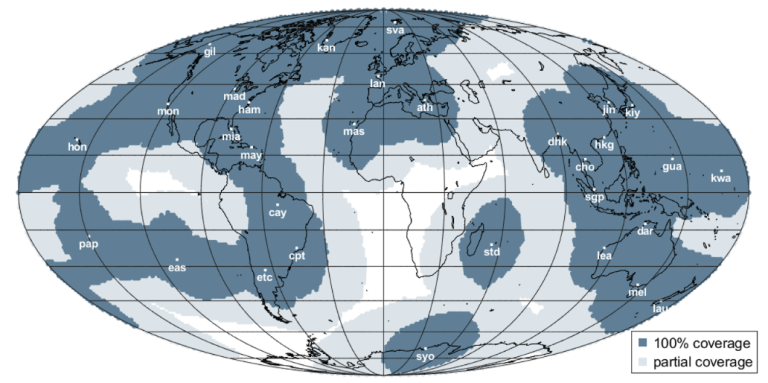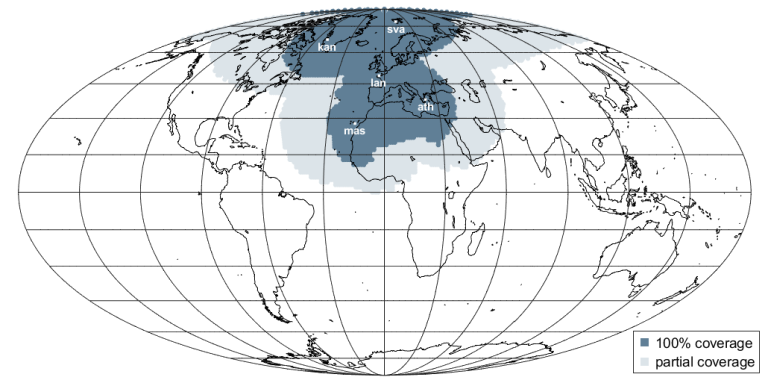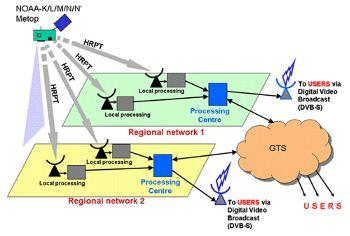Data Access and Use
Direct Broadcast Network (DBNet)
The Direct Broadcast Network (DBNet) is a set of operational arrangements for the real-time acquisition of Low Earth Orbit (LEO) satellite data through a worldwide network of local, Direct Broadcast receiving stations and the rapid delivery of these data to the global user community after pre-processing and formatting in accordance with agreed standards.
Motivation
Sounder data from LEO satellites (in particular from the ATOVS suite of instruments) are among the most important sources of observation used by Numerical Weather Prediction (NWP) models. A brief description of the benefits they bring can be found in ATOVS-impact-on-assimilation-JMA-2007. Like all NWP model inputs, their assimilation is constrained by their time of availability. While locally received data (via Direct Readout reception systems) can be available in a timely fashion for the NWP models, the availability of global data is delayed by the storage time on-board the spacecraft and the procedures involved for the data collection, processing and distribution. The DBNET concept enables the delivery of LEO data, in particular sounder data, collected from a regional network of HRPT stations within the timeliness constraints imposed by NWP models.
However, not all WMO regions are well-served by HRPT data collection networks and so the main objective of DBNet is to facilitate the introduction of such regional networks, together with appropriate regional dissemination mechanisms, and inter-regional data exchange facilities, across the globe.
Background
DBNet has its roots in the EUMETSAT ATOVS Re-transmission Service (EARS). EARS was initially established in 2002 in response to the requirements of Limited Area NWP modelling over Europe (HIRLAM then ALADIN) whose modelling area exceeded the coverage of a single HRPT station, and whose timeliness constraints were not compatible with the current scheme of global data collection. By merging the data sets from several HRPT stations EARS enabled the extended coverage and short timeliness requirements of the NWP operators to be met.
In recognition of the very positive impact that EARS data made to NWP model performance, the Co-ordination Group for Meteorological Satellites (CGMS), at its thirty-second session in May 2004, asked whether the system could be expanded into other Northern Hemisphere regions, and then extended to cover the Southern Hemisphere.
With this aim in mind the CGMS encouraged the WMO Space Programme to contact CGMS members and potential regional participants with a view to forming local consortia to develop Regional ATOVS Retransmission Services similar to EARS. In response to the WMO Space Programme in 2004 started the RARS project.
After the launch of the Suomi-NPP and FY-3 satellites with new suites of instruments, it was recognized that the scope of the RARS project needed to be extended and in 2015 the RARS partners agreed to rebranding the initiative as the “Direct Broadcast Network for Near Real-Time Relay of Low Earth Orbit Satellite Data" (DBNet)
An important consideration in the establishment of regional collection networks is the capability to deliver homogeneous sets of data from different sources to NWP Centres so that they can merge them with confidence. Hence DBNet also places considerable emphasis on the standards that DBNet Operators should adhere to, in order to guarantee the global consistency of the various DBNet data sets.
DBNet Benefits for Numerical Weather Prediction (NWP)
Observations from satellite-based instruments impact the performance NWP models to an extent that exceeds the sum of all other observation types. The strongest impact is obtained from instruments sensitive to atmospheric temperature and humidity, this includes for example instruments measuring the atmosphere in the microwave and infrared spectrum. Satellite observations play particularly important role due to their global coverage, and consequently the NWP model skill over data sparse areas, like oceans and remote land areas, is markedly improved.
Data assimilation is usually a sequential time-stepping procedure, in which a previous model forecast is compared with newly received observations, the model state is then updated to reflect the observations, a new forecast is initiated, and the cycle is repeated. Measurements from satellite and other observing systems are grouped into time windows around the initial time from which the forecast is to be launched. To allow time for the data assimilation and forecast model to be run, NWP centres typically apply a cut-off time, after which no more new observations are accepted into the assimilation cycle. Observations at the end of the assimilation window are the last to be measured and are therefore most vulnerable to miss this cut-off time if there are delays in delivering the data to the NWP centres.
NWP models are run over a range of different domains varying from global to continental and regional. The choice of the model resolution is governed by several factors, including the ability of the model to represent the complex atmospheric processes at the chosen resolution, the availability of observational data at the model resolution and the available computer power. Generally, the higher resolution and smaller domain versions of the models are run with a shorter data assimilation window than that for the global model. These arguments feed into the motivation and background for the DBNet initiative.
DBNet products can impact the performance of NWP systems in two different ways:
1. Increase in number of observations available for data assimilation
The impact of increased availability data for the performance of short cut-off forecasts have been demonstrated through data denial experiments. Lin et. al. (https://journals.ametsoc.org/view/journals/wefo/32/4/waf-d-16-0215_1.xml, 2017) presents such an experiment with assimilation of AMSU-A data in the NOAA Hourly regional RAP mode with a very short cutoff time of 25 minutes. The study concludes that satellite radiance data has small but consistent positive impact with significance for the hourly updated RAP model system. Reduced data latency available through DBNet direct readout was essential for the result.
2. Observational impact of low latency data in variational assimilation
Modern data assimilation techniques, such as 4-dimensional variational assimilation, can make use of the observations at their observation time within the assimilation window and it has been demonstrated that the observations located near the end of the assimilation window are the most influential. This is fully analysed in the article by A. McNally (https://rmets.onlinelibrary.wiley.com/doi/10.1002/qj.3596, 2019). The results of the study highlight how critical these late window data are and thus reinforce the need for data producers to continue their efforts to reduce data dissemination delays as far as possible, with initiatives such as DBNet.
Concrete NWP impact studies demonstrating the effect of DBNet had not be performed until the recent work of Peter Lean (ECMWF) which was presented at the 8th WMO Workshop on the Impact of Various Observing Systems on Numerical Weather Prediction and Earth System Prediction (https://community.wmo.int/en/meetings/8th-wmo-impact-workshop-home, 2024 incl. presentations). This impact study simulates the possible profiles of arrival of observations by applying different constant delays to all microwave sounding data instead of using the actual data latency, and provides clear evidence of the positive impact of reducing the data latency. From conclusions of the presentation:
- Timeliness is an intrinsic characteristic of an observing platform (alongside instrument noise etc) which affects the impact that they have on real-time NWP forecasts and when planning new instruments, it should be given serious consideration
- Since the introduction of Continuous DA in CY46R1 ECMWF has been able to assimilate more low latency observations and so stand to gain more from improved timeliness
- Around 25% of the potential impact of MW sounders at day 3 is lost if the delivery delay is 100 minutes
- A real-world example adding extra DBNet stations highlights that the impact is highly dependent on the coverage of the ground stations, the geometry of the orbits and the assimilation window used
Outlook
Both types of impact described above are particularly crucial for Continuous Data Assimilation as it has been operationally implemented at ECMWF, see Peter Lean et. al. (https://rmets.onlinelibrary.wiley.com/doi/10.1002/qj.3917, 2017) and by other NWP centres.
WMO, the DBNet community and the satellite operators strongly encourages to perform further impact studies analysing the impact of DBNet products on NWP, as the data latency target is a key design and cost driver for future satellites and associated ground systems.
DBNet system concept
Compared with the normal means of access to global data, this approach allows access by users to a regional sub-set of data without the delay associated with on-board data storage prior to a full orbit data dump to a Command and Data Acquisition station.
The way in which the global DBNet network is built from individual regional networks with using the GTS for inter-regional exchange is shown in this diagram
DBNet Implementation Status
The status of implementation of the main DBNet services is shown in the following diagrams

| 
|
| DBNet-ATOVS coverage in December 2025 | DBNet-ATMS coverage in December 2025 |

| 
|
| DBNet-IASI coverage in December 2025 | DBNet-CrIS coverage in December 2025 |

| |
| DBNet-VASS coverage in December 2025 | plots by Antoine Jeanjean, EUMETSAT |
A list of the current and planned participating HRPT stations is available (DBNet Network Status and Plans), with their geographical coordinates and BUFR identifiers. The planned expansions will contribute to filling the geographic gaps visible on the graphics.
DBNet Product Monitoring
Data quality flags and other indicators are generated when the data are processed by the AAPP software. Embedded in the format of the retransmitted data, they alert to any inherent quality problems that might be present in the data themselves.
Routine DBNet data monitoring takes place at two levels:
- The Regional Processing Centres are responsible for monitoring the performance of the DBNet in their region; in particular to monitor timeliness and completeness of the products.
- The EUMETSAT Satellite Application Facility on Numerical Weather Prediction (NWP SAF) is monitoring the data quality provided by the whole DBNet network and in particular routinely compares the products from all DBNet with corresponding (full orbit) global data.
Monitoring by Regional Processing Centres
Service-related information is also gathered and published by the respective DBNet Regional Processing Centres. They monitor the completeness of the data that they receive from direct readout stations by comparison with the data expected from the nominal regional configuration. Additional factors are monitored by regional centres such as end-to-end timeliness indicators, or consistency of the navigation.
Monitoring by the NWP SAF
The NWP SAF lead institute, the UK Met Office, is responsible for routinely and automatically performing comparisons of DBnet data sets and the equivalent data in the global data sets received via another means. In this way the DBNet data sets are examined for consistency with equivalent data that has not passed through the DBNet processing chain. Such consistency is vital to enable the DBNet data to be used alongside global data, for example, in NWP applications.
The NWP SAF publishes the results of the consistency checks on the NWP SAF web site and has the capability to generate alerts and send them via email to the appropriate centre. Data locally received in Exeter, UK are also compared with corresponding DBNet data.
DBNet Data Access
Identifying the data of interest
The first step is to know what area you would like data from. The areas for which DBNet data are available, and the corresponding centre(s), are graphically illustrated in the status graphics above.
If data is available from the considered area, the next step is to identify the particular reception stations from which data is required. The coordinates of each station and their associated processing centre are indicated in the DBNet Network Status and Plans.
The normal mechanism for receiving data is via the Global Telecommunications System (GTS). In some cases other mechanisms are available such as DVB-S broadcasts, or FTP over the Internet.
To receive data via the GTS
To receive data via the GTS, users should contact their National Meteorological or Hydrological Service (NHMS) indicating the nature of the data that is required. The detailed identifyers and data descriptors for each reception station are given in the DBNet Coding Summary.
The point of contact within the NMHS is the Regional Telecommunication Hub (RTH). The list of RTH Focal Points per country is available in List of RTH Focal Points.
To receive data via other mechanisms
To receive data via other mechanisms (if supported) users should contact the DBNet Centre associated with the particular reception station (DBNet Network Status and Plans). The contact details for each DBNet Centre are given below. The contact point will then inform the user about the relevant procedures to be followed for obtaining access to the data.
DBNet Contacts and Links
DBNet Contact Points (updated 10 December 2025)
| Role | Name | Email address |
|---|---|---|
| DBNet Asia-Pacific Co-ordinators | Mr STEPHEN HAYNES Mr Toshiyuki Kitajima | STEPHEN [dot] HAYNES kitajimatoshiyuki |
| DBNet South America Co-ordinators | Dr Renato Galante NegrI Ms Maria Paula Hobouchian | renato [dot] galante phobouchian |
| DBNet EUMETSAT (EARS) Co-ordinator | Mr Nicholas Coyne | nicholas [dot] coyne eumetsat [dot] int (nicholas[dot]coyne[at]eumetsat[dot]int) eumetsat [dot] int (nicholas[dot]coyne[at]eumetsat[dot]int) |
| DBNet NOAA coordinator | Dr Lihang Zhou Mr Liam Gumley | lihang [dot] zhou liam [dot] gumley |
| WMO Space Programme | Dr Mikael Rattenborg Ms Zoya Andreeva | mikael zandreeva |
Links to Websites of DBNet Operators
(for operational information concerning the provision of the DBNet services)
| DBNet | Web site |
|---|---|
| EUMETSAT (EARS) | EUMETSAT Advanced Retransmission Service (EARS) | EUMETSAT - User Portal |
| Asia-Pacific | |
| South America | https://catalogos.conae.gov.ar/catalogo/DatosDBNet/DatosDBNet.html |
| NOAA | Not available |
Other Links
NWP SAF: https://nwp-saf.eumetsat.int/site/ (Providing AAPP Software and global monitoring)
NWP SAF global monitoring: https://nwp-saf.eumetsat.int/site/monitoring/dbnet/
DBNet Documents
- Guide to DBNet
- DBNet satellite acquisition priorities (recommended by DBNet-CG-8, December 2025)
- DBNet Network Status and Plans (DBNet-CG-8, December 2025)
- DBNet Coding summary
- DBNet Newsletters
DBNet Coordination Group Meetings
- 8th DBNet Coordination Group Meeting (DBNet-CG-8) (Online, 9-10 December 2025)
- DBNet Coordination Group Intersessional Meeting (DBNet-CG-IS#2) (Online, 12 March 2025)
- DBNet Coordination Group Intersessional Meeting (DBNet-CG-IS#1) (Online, 10 October 2024)
- 7th DBNet Coordination Group Meeting (DBNet-CG-7) (Melbourne, Australia, 19-21 March 2024)
- DBNet Coordination Group Intersessional Meeting (DBNet-CG-IS#2) (Online, 12 October 2023)
- DBNet Coordination Group Intersessional Meeting (DBNet-CG-IS#1) (Online, 5 April 2023)
- 6th DBNet Coordination Group Meeting (DBNet-CG-6) (Geneva, Switzerland, 4-6 October 2022)
- 5th DBNet Coordination Group Meeting (DBNet-CG-5) (Online, 23-25 November 2021)
- 4th DBNet Coordination Group Meeting (DBNet-CG-4) (Online, 20-22 October 2020)
- 3rd DBNet Coordination Group Meeting (DBNet-CG-3) (Paris, France, 23-25 October 2018)
- 2nd DBNet Coordination Group Meeting (DBNet-CG-2) (Geneva, Switzerland, 20-22 September 2016)
- 1st DRARS Coordination Meeting (DRARS-CG-1) (Geneva, Switzerland, 11-13 March 2015)
- 6th RARS Implementation Group Meeting (RARS-IG-6) (Exeter, United Kingdom, 25-26 October 2012)
- 5th RARS Implementation Group Meeting (RARS-IG-5) (Boulder, USA, 2011)
- Joint 4th meeting of the RARS and IGDDS Implementation Groups (RARS-IGDDS IG-4) (Geneva, Switzerland, 22-24 March 2010)
- Joint 3th meeting of the RARS and IGDDS Implementation Groups (RARS-IGDDS IG-3) (Tokyo, Japan, 5-6 March 2009)
- 2nd RARS Implementation Group Meeting (RARS-IG-2) (Geneva, Switzerland, 20-21 May 2008)
- 1st RARS Implementation Group Meeting (RARS-IG-1) (Geneva, Switzerland, 3-4 July 2007)
DBNet Publications and Posters
A global network of Regional ATOVS Retransmission Services (RARS), by M.Dumont, J. Lafeuille, A.Soerensen. Paper presented at the 15th International TOVS Study Conference (ITSC XV, Maratea, October 2006).
Update on the RARS project, by D. Griersmith, paper presented at the 16th International TOVS Study Conference (ITSC XVI, Angra dos Reis, Brazil, May 2008)
Evolution of the EUMETSAT Advanced Retransmission Service (EARS), by C. Ponsard, A. Soerensen, D. Lee, at NOAA's 2008 Satellite Direct Readout Conference (Miami, Florida, USA, 8-12 December 2008).
RARS Global Network Status and Plans, by J. Lafeuille, poster presented at the 17th International TOVS Study Conference (ITSC XVII, Monterey, Ca, USA, 14-20 April 2010)
WMO Space Programme data access challenges: update on the RARS initiative, by J.Lafeuille, Netspace Workshop, Athens, February 2014.

